Aerospace

The Effects of Amplified Head Rotations on Flight Simulation Training Devices
Summary
Flight simulation training devices, unless equipped with highfidelity, panoramic field of view visual displays, are restricted in their usage for training of visual flight maneuvers. This research highlighted as such the current training limitations of low-fidelity simulators. By smart integration of virtual reality technology, amplified head rotations have been shown to be capable of augmenting visuals on such systems, giving equivalent performance/training capability to higher-fidelity systems, a feat previously unattainable.
Aims and Objectives
Assess the meaningful effectiveness of amplified head rotations in the work domain of low-fidelity flight training simulation devices on benefits of pilot performance and side effects. This utility evaluation is the first step in a multistage systematic evaluation approach to quantify the value of simulator-based training.
The top-level objectives are: (i) measuring the performance of pilots during various flying tasks while using different display configurations with and without view augmentation; (ii) evaluating pilot workload (mental, physical) due to augmentation; (iii) report the occurrence of any simulator sickness during the trials.
Research being undertaken
A full literature review identified the emerging need for distributed mission operations and how current, high fidelity flight simulators with large field of view displays were too expensive to be able to deploy on a large scale
and too cumbersome to be able to be relocated at will. Fidelity versus training effectiveness studies were also reviewed, indicating that smart usage of systems with lower fidelity can yield equivalent training benefits as high fidelity setups. Literature suggested that amplified head rotations allow users to pan their view around in the virtual environment, effectively enabling unlimited field of regard in limited field of view environments. To support this hypothesis, a series of piloted experiments was designed to gather objective data as well as user feedback.

Cockpit Display System

Experimenter's Cockpit Control Systems
Results
Preliminary results showed that there was a significant difference between displays for the first experiment: turns were initiated closer to the centerline with larger bank angles on the augmented single display.
The second experiment indicated that for traffic spotting, the projectors with its large FOV had the lowest
amount of missed spotting and the single display the worst. Flight technical errors were not yet significant.
Conclusions
The goal of providing recommendations of optimal usage has been achieved. The findings so far demonstrate the potential value of upgrading flight training devices and remotely piloted vehicle ground stations to improve their utility.Developments like this are very attractive for integration into low-cost flight simulators. This would translate into affordable, smart training access to a large number of users.
Expected Impact
Applications of this research include virtual environment training, simulation, and entertainment systems. It will offer not only the (aviation) simulation industry but consumers as well insight into optimal use of their simulator setup, previously undocumented.
Publications
L. Le Ngoc and R. S. Kalawsky. Evaluating Usability of Amplified Head Rotations on Base-to-Final Turn for Flight Simulation Training Devices. In IEEE Virtual Reality 2013. IEEE, in press 2013.
L. Le Ngoc and R. S. Kalawsky. Expanding Virtual Mission Training via Low-cost Head-tracking Augmentation. In RAes Spring Flight Simulation Conference 2013. Royal Aeronautical Society, accepted 2013.
L. Le Ngoc and R. S. Kalawsky. Visual Circuit Flying with Augmented Head-tracking on Limited Field of View Flight Training Devices. In AIAA Modeling and Simulation Technologies Conference 2013. AIAA, submitted 2013.
L. Le Ngoc. Advancing Low-fidelity Flight Simulators Through Amplified Head Rotations. In Doctoral Consortium, IEEE Virtual Reality 2013. IEEE, submitted 2013.
L. Le Ngoc and R. S. Kalawsky. A Systems Framework to Off-the-Shelf Technology Integration for Flight Simulation Research. In Workshop on Off-The-Shelf Virtual Reality, IEEE Virtual Reality 2013. IEEE, submitted 2013.
Download a pdf containing this information
